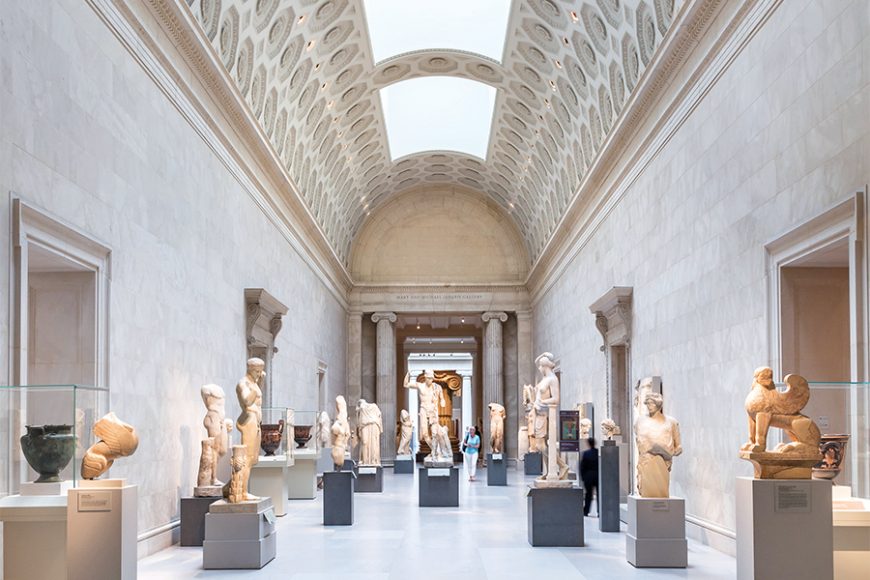A year after the Civil War ended, a group of New Yorkers met in Paris’ Bois de Boulogne, where they celebrated victory and peace amid the bucolic beauty of the iconic park on the western edge of the 16th arrondissement.
Their thoughts, however, were very much on their own city, thousands of miles away and what they could do to enrich it culturally.
“I think they wouldn’t even hope to create a museum like those they encountered on their grand tours of Europe,” said Andrea Bayer, The Metropolitan Museum of Art’s deputy director of collections and administration. “But they felt New York deserved a serious museum.”
The time was ripe, Bayer added. Post-Civil War, Northern cities were feeling their oats. The Museum of Fine Arts, Boston was founded in 1870. The American Museum of Natural History — the scientific yang to The Met’s yin across Central Park — was founded in 1869.
That year, the idea of a New York art museum was referred to the art committee of the Union League Club of New York, with The Metropolitan Museum of Art incorporated on April 13, 1870. It had no building yet or collection, just a group of elected trustees and executive committee members. But it had one thing more — a dream that has grown from makeshift homes in midtown and on 14th Street to a Central Park building in 1880, which became the expansive Beaux Arts jewel that today houses 17 curatorial departments, in effect 17 individual museums.
To a tea
It’s no secret that the 2010s was, however, not the best of times for The Met, with a crisis in leadership that manifested itself in personnel issues, financial troubles and a controversial experiment with The Met Breuer, its museum of Modern and contemporary art, housed in the former, revamped Whitney Museum of American Art.
But now with Daniel H. Weiss as president and CEO and Max Hollein as director, The Met has rebounded spectacularly. One proof of this is in the ambitious lineup of exhibits, programs, lectures, panels, concerts and interactive experiences the museum has designed to celebrate its 150th anniversary and demonstrate that it remains one of the great august but also democratic institutions of the world, accessible to all. Another proof is in Bayer herself, one of three women deputy directors at The Met. The trio is completed by Inka Drögemüller, deputy director for digital, education, publications, imaging, libraries; and Quincy Houghton, deputy director of exhibitions — demonstrating, Bayer said, that women are making strides in museum leadership.
Since joining The Met as an Italian Renaissance scholar in the Department of European Paintings in 1990, the Barnard- and Princeton-educated Bayer has proved to be knowledgeable and passionate, the perfect blend of sense and sensibility and an invaluable resource for us cultural writers. Recently, WAG had the opportunity to discuss with her the big plans for the big 150, which kick off with a happy happenstance. When Met officials were planning the sesquicentennial celebration, they had no idea that the refurbishment of the British galleries would be completed in time for the 150th anniversary. So the celebration begins March 2 with the opening of the newly installed Annie Laurie Aitken Galleries and Josephine Mercy Heathcote Gallery — 11,000 square feet featuring almost 700 works of British decorative arts, design and sculpture created between 1500 and 1900. The reimagined suite of 10 galleries (including three 18th-century interiors) offers a new take on a past filled with achievement but also complexity and pain. This will be seen in a much-anticipated gallery devoted to “Tea, Trade and Empire,” which presents a delightful display of 100 English teapots while also considering the human and environmental price for such lovely prosperity.
‘Making The Met’
The centerpiece exhibit of the anniversary year is “Making the Met: 1870-2020” (March 30-Aug. 2), which Bayer organized to tell the chronological and thematic story of The Met in eight sections that draw on the entire collection. The first, “The Founding Decades,” notes the diversity of The Met’s holdings from the get-go, everything from Cypriot antiquities and Toltec reliefs to Japanese armor and Old Masters. The museum sought a wide audience, too, with study rooms for designers, artisans and students. The “Art for All” section demonstrates how The Met encouraged that mass appeal through the creation of its musical instruments collection; its textiles offerings, now the Antonio Ratti Textile Center and Reference Library; and a prints department that embraced everything from broadsheets to the works of the Northern Renaissance master Albrecht Dürer, Bayer said.
“In the early years, there was a great debate: Should The Met be open on Sunday?,” she added. “Sunday was the day for the workingman. But the strict Protestants who founded The Met thought that was not right. It took (some 20) years for The Met to open on Sundays,” the first being May 31, 1891. Today The Met is open seven days, the exceptions being Thanksgiving, Christmas, New Year’s Day and, of course, the first Monday in May for its Costume Institute Gala. And it remains committed to reaching out to viewers through the media of the day, with “Primers” on upcoming exhibits from director Hollein on its website and #MyMetStory serving for a collection of visitors’ reminiscences of their Met experiences.
“Princely Aspirations” looks at the inspiration the museum drew from the great royal and aristocratic collections, while “Collecting Through Excavation” considers not only the great discoveries of the 1920s and ’30s but how the policy has changed to research and conservation since The Met began excavating in the Middle East in 1906.
“Creating a National Narrative” chronicles the run-up to the opening of the American Wing in 1924, while “A Vision of Collection” illustrates how the 1929 bequest of some 2,000 objects from Louisine and Henry Osborne Havemeyer exploded The Met’s holdings in European, American, Asian and Islamic art. (Many of these works were displayed at Hilltop, the Havemeyers’ 90-acre Greenwich estate.) Louisine was a great friend of Mary Cassatt, the only American artist invited to exhibit with the French Impressionists, and Cassatt presciently encouraged the couple to buy Impressionist works. She played a key role in The Met becoming one of the great repositories of 19th century art.
Days of ‘Reckoning’
But The Met would soon lag in other areas, a subject it acknowledges in the “Reckoning with Modernism” section of “Making The Met.”
“It is complicated,” Bayer acknowledges. “I don’t want to underestimate the complications of history. Every generation confronts its own modern.” But while The Met was quick to embrace changing styles of furniture, it wasn’t as quick to accept Modernism in painting and sculpture or even new art forms. It took 20 years for it to receive Alfred Stieglitz’s photographs as fine art. It never did accept the Gertrude Vanderbilt Whitney collection, which became the Whitney Museum. The promised billion-dollar gift of Leonard A. Lauder’s Cubist paintings, drawings and sculptures, however, will fill in what has been a gap in The Met’s holdings from the 1920s and ’30s, Bayer said.
At the same time, The Met is ending its run at The Breuer after the “Gerhard Richter: Painting After All” show (March 2-July 5). The Frick Collection will take over the lease during the renovation of its 70th Street home. But Bayer calls The Breuer experiment “enormously successful,” pointing to such shows as her own excellent “Unfinished Thoughts Left Visible,” featuring provocative, “finished” unfinished works that spanned the Renaissance to the present.
Bayer rounds out “Making The Met” with sections on “Fragmented Histories” and the museum’s role in helping the Monuments Men and Women preserve the cultural heritage of Europe during World War II; “The Centennial Era” that explored the arts of Islam, Asia, Africa and Oceania; and “Broadening Perspectives,” which considers the importance of cross-cultural approaches.
Those cross-cultural currents will flow March 4 in the “Crossroads” series of installations — “Power and Piety” in the Medieval Sculpture Hall; “Empires and Emporia” in the Asian Art Galleries Astor Forecourt; and “Mythical Beasts” at the intersection of Greek and Roman Art, Ancient Near Eastern Art, and Art of the Arab Lands, Turkey, Iran, Central Asia and Later South Asia galleries.
With all of this, what would those men dreaming in the Bois de Boulogne think of The Met today?
Said Bayer: “I think they would be completely gobsmacked, amazed at the grandeur and the scale that draws seven million visitors a year.”
For more, visit metmuseum.org/150 and contribute your recollections at metmuseum.org/Share-Your-Met-Story.





